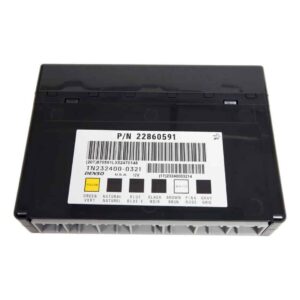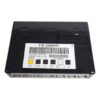Restore Your Vehicle’s Electronic Stability and Functionality
Are you dealing with a cascade of bizarre electrical problems in your GM vehicle? Flickering lights, malfunctioning power windows, a security system that acts up randomly, or even a no-start condition can all point to one culprit: a failing Body Control Module (BCM). As a technician with over two decades of experience, I’ve seen how a faulty BCM can turn a reliable vehicle into a source of constant frustration. It’s the central command center for all your vehicle’s body electronics, and when it fails, it creates chaos.
This isn’t just a replacement part; it’s a complete, hassle-free solution. We take the guesswork and the expensive dealership visits out of the equation. Simply provide us with your vehicle’s VIN after purchase, and we will program this BCM with the latest GM software specific to your vehicle. It arrives at your door ready for installation, saving you time, money, and the headache of coordinating with a programming service. This is the most direct way to get your truck, van, or SUV back to factory-spec operation.
A Technician’s Notebook: The Ghost in the Machine
Just last month, a 2010 Chevy Tahoe was towed into the bay. The owner was at his wit’s end. The dash lights would flicker, the radio would turn on and off by itself, and the anti-theft system would engage randomly, preventing it from starting. He’d already replaced the battery and checked the alternator. After connecting my scan tool, I found a slew of ‘U’ codes (Communication DTCs), indicating a network problem. This is a classic sign that the BCM, the network gateway, is failing internally. We installed a VIN-programmed BCM just like this one, and within an hour, all the ghostly electrical issues were gone. It’s a fix I’ve performed hundreds of times on these GM platforms.
Is Your GM Vehicle Showing These Symptoms?
A failing BCM can manifest in numerous ways. If you’re experiencing any of the following, this module is the likely solution.
- ✔ Erratic or non-functional interior and exterior lights.
- ✔ Power windows, door locks, or mirrors working intermittently or not at all.
- ✔ The security or anti-theft system preventing the vehicle from starting.
- ✔ False warnings on the dashboard or instrument cluster.
- ✔ Diagnostic trouble codes (DTCs) related to communication errors, such as U0100, U0140, or other U-series codes.
- ✔ Unresponsive key fobs or remote start functions.
A Straightforward Guide to BCM Installation
Replacing the 2010 Tahoe Body Control Module is a manageable job for a confident DIYer or any professional mechanic. While the exact location varies by model (see fitment list), the process is generally similar.
- Safety First: Always disconnect the negative terminal from your vehicle’s battery before beginning any electrical work. Wait a few minutes for the system capacitors to discharge.
- Locate the BCM: On many vehicles like the Tahoe and Yukon, the BCM is located under the driver’s side of the dashboard, near the steering column. On vans or other models, it may be in the center dash area.
- Remove Trim Panels: Carefully remove any plastic trim panels necessary to access the module. Use a trim removal tool to avoid breaking any clips.
- Disconnect and Remove: The BCM is held in place by a few bolts or clips. Unplug the electrical connectors—they have locking tabs that must be depressed. Once disconnected, remove the old module.
- Install the New BCM: Mount your new, pre-programmed BCM in place and securely reconnect all electrical connectors. You should hear a ‘click’ as they lock.
- Post-Installation Procedures: Reconnect the battery. Follow the critical post-installation steps outlined below to ensure full system functionality.
Important Post-Installation Steps
Because this 2010 Tahoe Body Control Module is the central hub for many systems, a couple of procedures are required after installation to ensure safety and performance. These steps typically require a professional-grade scan tool.
- Airbag System Reset: To clear the airbag warning light, the ‘Setup SDM Primary Key in BCM’ procedure must be performed. This re-establishes the security handshake between the new BCM and the airbag system’s Sensing and Diagnostic Module (SDM).
- Brake Pedal Position Sensor Relearn: On some models, the Brake Pedal Position (BPP) sensor may need to be recalibrated. This ensures the brake lights and stability control systems receive accurate data from the brake pedal.
Guaranteed Fitment for Your Vehicle
This module is a direct replacement for a wide range of General Motors vehicles and interchanges with numerous part numbers. Please verify your vehicle is on this list. This unit replaces part numbers including: 15819552, 15921353, 20815898, 20864767, 20935349, 22860591, 25892622, 25934762, 25934763, and many more.
Frequently Asked Questions
Do I need to do any programming after I receive this BCM?
No. This Body Control Module comes fully programmed to your vehicle’s VIN. You just need to provide your VIN at checkout. However, post-installation procedures like an airbag key setup or brake pedal relearn may be required with a scan tool.
Is this a brand new part?
This is a high-quality, tested, and verified OEM part that has been inspected and programmed with the latest software from GM for your vehicle. It is guaranteed to restore original functionality.
Where is the BCM located on a 2010 Chevy Tahoe?
On the 2010 Tahoe, the BCM is typically located under the driver’s side dashboard, to the left of the steering column. You will likely need to remove the lower dash panel to access it.
Will this fix a “Service StabiliTrak” or “Service Traction Control” message?
While a faulty BCM can sometimes contribute to these warnings by disrupting communication, these messages are more commonly caused by wheel speed sensors, the steering angle sensor, or the electronic brake control module (EBCM). Proper diagnosis is key, but if you have other BCM-related symptoms, this could be part of the solution.
What happens if I don’t perform the post-installation procedures?
If you skip the ‘Setup SDM Primary Key’ procedure, the airbag warning light will likely remain illuminated on your dash. If the brake pedal relearn is required and not performed, you may have issues with brake light operation or stability control activation.



